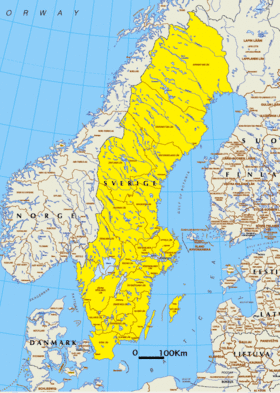Difference between revisions of "Marine Biotechnology in Sweden"
| Line 1: | Line 1: | ||
| − | |||
{{Marine Biotechnology | {{Marine Biotechnology | ||
|Image=Image:Sweden map.gif | |Image=Image:Sweden map.gif | ||
Revision as of 16:48, 8 March 2013
Go back to: Home > Strategies, Policies and Programmes > European countries
Overarching science strategies, plans and policies
There is currently no dedicated Marine Biotechnology policy or strategy in Sweden. Overarching research priorities of the Swedish government for the period 2013-2016 are determined by the Swedish Research and Innovation Bill.
Research funding schemes and programmes
The Ministry for Education and Science is responsible for the overall co-ordination of research policy activities and for direct research funding via the Swedish Research Council. The ministry is also responsible for the design of framework conditions for the National Science and Innovation System with a focus on basic research and university education.
- Vinnova has a programme dedicated to industrial biotechnology. It aims to stimulate research and development and the implementation of industrial biotechnology in various sectors in order to promote more environmentally friendly processes linked to economic growth. SEK 50million was granted in the first call as project support in 2008. Mats Jarekrans is in charge of the programme.[3]
- VINNOVA also runs a programme named “VINNVÄXT” which in June 2008 granted SEK 13million to Processum Biorefinery Initiative for a project called “The future biorefinery" [4]
- Mistra7 (The Foundation for Strategic Environmental Research) funds a programme called Greenchem – Specialty Chemicals from Renewable Resources8. The program runs from 2003 to2010 with Lund University as the main contractor. The Mistra support is SEK 71,4 million. A groupof 8 industries which represent renewable raw material providers as well as producers and users of chemicals participate in the programme.[5]
Research priorities for marine biotechnology research
n/a
Strategic documents
Infrastructures and coordination and support capacities / initiatives
- In 2012, Sweden operates 6 local/coastal vessels from 11,8m to 24 m; 4 regional vessels from 38m to 46m; 1 oceanic of 61,17m (Argos), and 1 global vesselsof 107,8m (Oden) registered at the European Research Vessels Infobase [8].
- In 2012, Sweden maintains about 2 large marine research equipments registered in the European large Exchangeable instruments database [8].
- Key aquaculture experimental and research facilities in Sweden include
- Specialised Laboratories (Swedish University of Agricultural Science)
- Salmon and trout experimental lab / Norrfors lab (department of Wildlife, fish and Environmental studies)
Major initiatives
- FP6 AQUAFUNC - Integrated knowledge on functional genomics in sustainable aquaculture [9] Coordinator: Dr Sundell Kristina UNIVERSITY OF GOTEBORG— Sweden
- FP7 ASSEMBLE - Association of European marine biological laboratories [10] Coordinator: Margareta AHLQWIST, GOETEBORGS UNIVERSITET - SWEDEN
References
- ↑ http://www.government.se/sb/d/16288
- ↑ http://www.regeringen.se/content/1/c4/11/10/08e3ecb4.pdf
- ↑ http://www.vinnova.se/In-English/Activities/Biotechnology
- ↑ http://www.vinnova.se/In-English/Activities/Strong-research-and-innovation-environments/VINNVAXT/
- ↑ http://www.greenchem.lu.se/
- ↑ http://www.iva.se/upload/Verksamhet/Projekt/Svensk%20bioteknik/Swedish%20biotechnology%20-%20web-1.pdf
- ↑ http://www.bio-economy.net/bioeconomy/member_states/sweden/files/report_sweden_final01.pdf
- ↑ 8.0 8.1 http://www.eurocean.org
- ↑ http://genomics.aquacultureeurope.org/
- ↑ http://www.assemblemarine.org/
Disclaimer
This country profile is based on available online information sources and contributions from various country experts and stakeholders. It does not claim to be complete or final, but should be considered as a dynamic and living information resource that will be elaborated, updated and improved as more information becomes available, including further inputs from experts and stakeholders. The information on this page is based on information initially compiled by the CSA MarineBiotech Project (2011-2013) and updated by the Marine Biotechnology ERA-NET (2013-2017).
